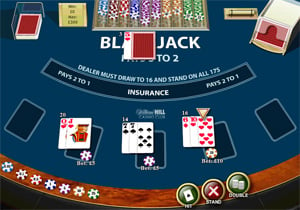How to bet in Blackjack
Blackjack is an extremely entertaining casino games that allows players to not only play for fun but also profit at your favourite online or mobile casino.
If you've played a game or two of blackjack and you have mastered basic blackjack strategy (or some semblance thereof) and are able to reduce the house edge to 0.5% when applying it, you may be wondering how to further optimise your game. The answer is in the way that you wager.
Here we'll take a look at the different ways to bet in blackjack and which we feel are the best to maximise profits.
Always betting the same amount
A blackjack player who continually wagers the same amount consistently is called following a flat betting strategy and is called a flat bettor. Not matter how much these players win or lose, they will always wager the same amount on each hand.
It's a conservative way to play that gets boring fast, however it is the best way to play if you are playing with a limited bankroll and want to get more game play time.
Another benefit is that when flat betting, calculating your theoretical hourly loss is easy. All you have to do is multiply the number of hands you play per hour by the amount bet per hand and times that by the house edge. Like so:
100 hands x $10 wagered per hand x 0.5% house edge = $5
And if you play for 5 hours, your theoretical loss is $5 x 5 = $25. Probably the biggest plus when flat betting is that you are able to reduce the swings in your bankroll. So while you may not win a great deal, you won't lose a lot either. The downside is that even though you'll enjoy both winning and losing sessions when you flat bet, over the long term your losses will still be greater than your wins, as the casino still carries the mathematical advantages, albeit greatly reduced by strategic blackjack play.
Betting Progression strategies
If you're someone that craves excitement, then you may use a betting progression strategy to liven up your blackjack game. When using a betting progression strategy players vary their wagers based on the results of their previous hand. While there are many betting progression variations, the most common is the "win progression" where you gradually increase the size of your wager after being dealt a winning hand. So, depending on your bankroll, you will double or triple the value of the bet on a win and when you lose during the progression, revert to your original bet value.
Betting progression strategies do not change the 0.5% house edge that you can obtain when playing according to sound blackjack strategy. Also, when using a win progression, your average bet will no longer be $10 because wagers increase in value. So if you're progressing from $10 to $10 and $30 per hand, your average bet will be around $15, and when comparing it to our example of the flat bettor's average theoretical loss, you'll see this strategy can result in a 1.5 times greater loss.
So while betting progressions do add excitement to the game, over the long run they don't really pay but if you have to play them, rather use a conservative one with smaller incremental increases.
Only increasing your bet value when you have the edge
This is a method that seems logical to most players, increasing the size of your wager when you know that you have the mathematical advantage on the next hand. The question is, how do you know when this happens?
The answer is you have to watch the cards as they are played during the game and remember what has been played from one round to the next, increasing your bet when you've seen a number of low value cards of two to six in previous hands. This may sound a lot like card counting, and it must be noted that this method will not work at online casinos, but it is the only way to gain a proven edge in the game of blackjack.
The method we're proposing isn't full on card counting, as most people don't have the time or mental acuity to learn it, but this method of watching cards and combining it with your basic strategy will help you to wipe out the theoretical hourly loss and give you the edge.

